What Influence Does Conventional Tillage Have on the Ability of Soils to Sequester Carbon, Stabilise It and Become Saturated in the Medium Term? A Case Study in a Traditional Rainfed Olive Grove
Abstract
:1. Introduction
2. Materials and Methods
2.1. Characterization of the Study Area
2.2. Experimental Design
2.3. Sample Preparation and Physico-Chemical Analysis
2.4. Statistical Analyses
3. Results and Discussion
3.1. Main Characteristics of the Soils Studied
3.2. Soil Mineral Fraction Size Distribution
3.3. Evolution over Time of Soil Organic Carbon by Aggregate-Size Fractions and Its Distribution in Depth
3.4. Relationship between Soil Organic Carbon and Soil Mineral Fraction-Clay
3.5. Soil Organic Carbon Saturation and Deficit of Saturation
3.6. Carbon Sequestration Potential in the Medium Term
4. Conclusions
Author Contributions
Funding
Data Availability Statement
Conflicts of Interest
References
- Intergovernmental Panel on Climate Change. Good Practice Guidance for Land Use, Land Use Change and Forestry; Penman, J., Gytarsky, M., Hiraishi, T., Krug, T., Kruger, D., Pipatti, R., Buendia, L., Miwa, K., Ngara, T., Tanabe, K., et al., Eds.; IPCC/OECD/IEA/IGES: Hayama, Japan, 2003. [Google Scholar]
- Trenberth, K.E.; Fasullo, J.T.; Kiehl, J. Earth’s global energy budget. Bull. Am. Meteorol. Soc. 2009, 90, 311–324. [Google Scholar] [CrossRef]
- Dignac, M.F.; Derrien, D.; Barré, P.; Barot, S.; Cécillon, L.; Chenu, C.; Chevallier, T.; Freschet, G.T.; Garnier, P.; Guenet, B.; et al. Increasing soil carbon storage: Mechanisms, effects of agricultural practices and proxies. A review. Agron. Sustain. Dev. 2017, 37, 14. [Google Scholar] [CrossRef] [Green Version]
- McDonough, W. Carbon is not the enemy. Nat. News 2016, 539, 349. [Google Scholar] [CrossRef] [PubMed] [Green Version]
- Lal, R. Soil health and carbon management. Food Energy Secur. 2016, 5, 212–222. [Google Scholar] [CrossRef]
- West, T.O.; Six, J. Considering the influence of sequestration duration and carbon saturation on estimates of soil carbon capacity. Clim. Chang. 2007, 80, 25–41. [Google Scholar] [CrossRef]
- Eglin, T.; Ciais, P.; Piao, S.L.; Barré, P.; Bellassen, V.; Cadule, P.; Smith, P. Historical and future perspectives of global soil carbon response to climate and land-use changes. Tellus B Chem. Phys. Meteorol. 2010, 62, 700–718. [Google Scholar] [CrossRef] [Green Version]
- Jobbágy, E.G.; Jackson, R.B. The vertical distribution of soil organic carbon and its relation to climate and vegetation. Ecol. Appl. 2000, 10, 423–436. [Google Scholar] [CrossRef]
- Lal, R. Managing soils and ecosystems for mitigating anthropogenic carbon emissions and advancing global food security. Bioscience 2010, 60, 708–721. [Google Scholar] [CrossRef]
- Le Quéré, C.; Andrew, R.; Canadell, J.; Sitch, S.; Korsbakken, J.; Peters, G. Global carbon budget 2016. Earth Syst. Sci. 2016, 8, 605–649. [Google Scholar] [CrossRef] [Green Version]
- Hassink, J. The capacity of soils to preserve organic C and N by their association with clay and silt particles. Plant Soil 1997, 191, 77–87. [Google Scholar] [CrossRef]
- Chen, S.; Arrouays, D.; Angers, D.A.; Martin, M.P.; Walter, C. Soil carbon stocks under different land uses and the applicability of the soil carbon saturation concept. Soil Till. Res. 2019, 188, 53–58. [Google Scholar] [CrossRef]
- Hassink, J.; Whitmore, A.P. A model of the physical protection of organic matter in soils. SSSAJ 1997, 61, 131–139. [Google Scholar] [CrossRef]
- Stewart, C.E.; Paustian, K.; Conant, R.T.; Plante, A.F.; Six, J. Soil carbon saturation: Evaluation and corroboration by long-term incubations. Soil Biol. Biochem. 2008, 40, 1741–1750. [Google Scholar] [CrossRef]
- Six, J.; Conant, R.; Paul, E.; Paustian, K. Stabilization mechanisms of soil organic matter: Implications for C-saturation. Plant Soil. 2002, 241–242, 155–176. [Google Scholar] [CrossRef]
- Feng, W.; Plante, A.F.; Six, J. Improving estimates of maximal organic carbon stabilization by fine soil particles. Biogeochemistry 2013, 112, 81–93. [Google Scholar] [CrossRef]
- Fujisaki, K.; Chapuis-Lardy, L.; Albrecht, A.; Razafimbelo, T.; Chotte, J.L.; Chevallier, T. Data synthesis of carbon distribution in particle size fractions of tropical soils: Implications for soil carbon storage potential in croplands. Geoderma 2018, 313, 41–51. [Google Scholar] [CrossRef]
- Verheye, W.; De la Rosa, D. Mediterranean soils. In Land Use and Land Cover, from Encyclopedia of Life Support Systems (EOLSS), Developed under the Auspices of the UNESCO. 2005. Available online: http://hdl.handle.net/10261/38282 (accessed on 12 February 2022).
- Cerdà, A.; Lavee, H.; Romero-Díaz, A.; Hooke, J.; Montanarella, L. Soil erosion and degradation on Mediterranean type ecosystems. Land Degrad. Dev. 2010, 21, 71–74. [Google Scholar] [CrossRef]
- Vicente-Vicente, J.L.; García-Ruiz, R.; Francaviglia, R.; Aguilera, E.; Smith, P. Soil carbon sequestration rates under Mediterranean woody crops using recommended management practices: A meta-analysis. Agric. Ecosyst. Environ. 2016, 235, 204–214. [Google Scholar] [CrossRef] [Green Version]
- Minasny, B.; Malone, B.P.; McBratney, A.B.; Angers, D.A.; Arrouays, D.; Chambers, A.; Chaplot, V.; Chen, Z.; Cheng, K.; Das, B.S.; et al. Soil carbon 4 per mille. Geoderma 2017, 292, 59–86. [Google Scholar] [CrossRef]
- Lal, R. Digging deeper: A holistic perspective of factors affecting soil organic carbon sequestration in agroecosystems. Glob. Chang. Biol. 2018, 24, 3285–3301. [Google Scholar] [CrossRef]
- Carretta, L.; Tarolli, P.; Cardinali, A.; Nasta, P.; Romano, N.; Masin, R. Evaluation of runoff and soil erosion under conventional tillage and no-till management: A case study in northeast Italy. Catena 2021, 197, 104972. [Google Scholar] [CrossRef]
- FAO; ITPS. Recarbonizing Global Soils—A Technical Manual of Recommended Management Practices; Volume 1: Introduction and Methodology; FAO: Rome, Italy, 2021. [Google Scholar] [CrossRef]
- Food Agricultural Organization (FAO). Recarbonization of Global Soils—A Tool to Support the Implementation of the Koronivia Joint Work on Agriculture; FAO: Rome, Italy, 2019; 12p, Available online: http://www.fao.org/3/ca6522en/CA6522EN.pdf (accessed on 17 April 2022).
- FAOSTAT. Food and Agriculture Organization of the United Nations—FAOSTAT Database; FAOSTAT: Rome, Italy, 2020; Available online: http://www.fao.org/faostat/en/#data (accessed on 17 April 2022).
- González-Rosado, M.; Lozano-García, B.; Aguilera-Huertas, J.; Parras-Alcántara, L. Short-term effects of land management change linked to cover crop on soil organic carbon in Mediterranean olive grove hillsides. Sci. Total Environ. 2020, 744, 140683. [Google Scholar] [CrossRef] [PubMed]
- Trigo, C.; Celis, R.; Hermosín, M.C.; Cornejo, J. Organoclay-based formulations to reduce the environmental impact of the herbicide diuron in olive groves. Soil Sci. Soc. Am. J. 2009, 73, 1652–1657. [Google Scholar] [CrossRef] [Green Version]
- Fernández-Romero, M.L.; Lozano-García, B.; Parras-Alcántara, L.; Collins, C.D.; Clark, J.M. Effects of land management on different forms of soil carbon in olive groves in Mediterranean areas. Land Degrad Dev. 2016, 27, 1186–1195. [Google Scholar] [CrossRef]
- Martínez, E.; Fuentes, J.P.; Acevedo, E. Carbono orgánico y propiedades del suelo. Rev. De La Cienc. Del Suelo Y Nutr. Veg. 2008, 8, 68–96. [Google Scholar] [CrossRef]
- IUSS Working Group WRB. World Reference Base for Soil Resources 2014, update 2015. In International Soil Classification System for Naming Soils and Creating Legends for Soil Maps; World Soil Resources Reports No. 106; FAO: Rome, Italy, 2015. [Google Scholar]
- Kottek, M.; Grieser, J.; Beck, C.; Rudolf, B.; Rubel, F. World map of the Köppen-Geiger climate classification updated. Meteorol. Z. 2006, 15, 259–263. [Google Scholar] [CrossRef]
- IFAPA. Instituto Andaluz de Investigación y Formación Agraria, Pesquera, Alimentaria y de la Producción Ecológica. Estación Meteorológica de Jaén. Available online: https://www.juntadeandalucia.es/agriculturaypesca/ifapa/riaweb/web/estacion/23/15 (accessed on 14 April 2022).
- González-Rosado, M.; Parras-Alcántara, L.; Aguilera-Huertas, J.; Benítez, C.; Lozano-García, B. Effects of land management change on soil aggregates and organic carbon in Mediterranean olive groves. Catena 2020, 195, 104840. [Google Scholar] [CrossRef]
- Álvaro-Fuentes, J.; Lóczy, D.; Thiele-Bruhn, S.; Zornoza, R. Handbook of Plant and Soil Analysis for Agricultural Systems; Crai UPTC Editions: Cartagena, Spain, 2019; 389p. [Google Scholar]
- Elliott, E.T. Aggregate structure and carbon, nitrogen, and phosphorus in native and cultivated soils. Soil Sci. Soc. Am. J. 1986, 50, 627–633. [Google Scholar] [CrossRef]
- Spielvogel, S.; Prietzel, J.; Kögel-Knabner, I. Soil organic matter changes in a spruce ecosystem 25 years after disturbance. Soil Sci. Soc. Am. J. 2006, 70, 2130–2145. [Google Scholar] [CrossRef]
- Steffens, M.; Kölbl, A.; Kögel-Knabner, I. Alteration of soil organic matter pools and aggregation in semi-arid steppe topsoils as driven by organic matter input. Eur. J. Soil Sci. 2009, 60, 198–212. [Google Scholar] [CrossRef]
- Blake, G.R.; Hartge, K.H. Bulk density. In Methods of Soil Analysis, Part 1: Physical and Mineralogical Methods, 2nd ed.; Klute, A., Ed.; ASA and SSSA: Madison, WI, USA, 1986; pp. 377–382. [Google Scholar]
- Nelson, D.W.; Sommers, L.E. Total carbon, organic carbon and organic matter. In Methods of Soil Analysis, Part 2: Chemical and Microbiological Properties. Agronomy Monograph; Page, A.L., Miller, R.H., Keeney, D., Eds.; ASA and SSSA: Madison, WI, USA, 1982; Volume 9, pp. 539–579. [Google Scholar] [CrossRef]
- Stolbovoy, V.; Montanarella, L.; Filippi, N.; Jones, A.; Gallego, J.; Grassi, G. Soil Sampling Protocol to Certify the Changes of Organic Carbon Stock in Mineral Soil of the European Union; Version 2; EUR 21576 EN/2. 56; Office for Official Publications of the European Communities: Luxembourg, 2007; ISBN 978-92-79-05379. [Google Scholar]
- Rytter, R.M. Stone and gravel contents of arable soils influence estimates of C and N stocks. Catena 2012, 95, 153–159. [Google Scholar] [CrossRef]
- Ojetade, J.O.; Adegbenro, R.O.; Muda, S.A.; Fawole, O.A.; Adesemuyi, E.A.; Amusan, A.A. Pedological investigation of benchmark soils in the upland area of rainforest southwestern Nigeria. Trop. Agric. 2021, 98, 101–132. [Google Scholar]
- Cerdà, A. Effects of rock fragment cover on soil infiltration, interrill runoff and erosion. Eur. J. Soil Sci. 2001, 52, 59–68. [Google Scholar] [CrossRef]
- González-Rosado, M.; Parras-Alcántara, L.; Aguilera-Huertas, J.; Lozano-García, B. No-Tillage Does Not Always Stop the Soil Degradation in Relation to Aggregation and Soil Carbon Storage in Mediterranean Olive Orchards. Agriculture 2022, 12, 407. [Google Scholar] [CrossRef]
- Zhang, S.; Li, Q.; Zhang, X.; Wei, K.; Chen, L.; Liang, W. Effects of conservation tillage on soil aggregation and aggregate binding agents in black soil of Northeast China. Soil Till. Res. 2012, 124, 196–202. [Google Scholar] [CrossRef]
- Gallardo, A.; Rodríguez-Saucedo, J.J.; Covelo, F.; Fernández-Alés, R. Soil nitrogen heterogeneity in a Dehesa ecosystem. Plant Soil 2000, 222, 71–82. [Google Scholar] [CrossRef]
- Pérez-Lomas, A.L.; Delgado, G.; Párraga, J.; Delgado, R.; Almendros, G.; Aranda, V. Evolution of organic matter fractions after application of co-compost of sewage sludge with pruning waste to four Mediterranean agricultural soils. A soil microcosm experiment. Waste Manag. 2010, 30, 1957–1965. [Google Scholar] [CrossRef]
- Aranda, V.; Ayora-Cañada, M.J.; Domínguez-Vidal, A.; Martín-García, J.M.; Calero, J.; Delgado, R.; González-Vila, F.J. Effect of soil type and management (organic vs. conventional) on soil organic matter quality in olive groves in a semi-arid environment in Sierra Mágina Natural Park (S Spain). Geoderma 2011, 164, 54–63. [Google Scholar] [CrossRef]
- Guimaraes, D.V.; Silva, M.L.N.; Beniaich, A.; Pio, R.; Gonzaga, M.I.S.; Avanzi, J.C.; Curi, N. Dynamics and losses of soil organic matter and nutrients by water erosion in cover crop management systems in olive groves, in tropical regions. Soil Tillage Res. 2021, 209, 104863. [Google Scholar] [CrossRef]
- Castro, J.; Fernández-Ondono, E.; Rodríguez, C.; Lallena, A.M.; Sierra, M.; Aguilar, J. Effects of different olive-grove management systems on the organic carbon and nitrogen content of the soil in Jaen (Spain). Soil Till. Res. 2008, 98, 56–67. [Google Scholar] [CrossRef]
- Hernanz, J.L.; Sanchez-Giron, V.; Navarrete, L. Soil carbon sequestration and stratification in a cereal/leguminous crop rotation with three tillage systems in semiarid conditions. Agric. Ecosyst. Environ. 2009, 133, 114–122. [Google Scholar] [CrossRef]
- Stolbovoy, V.; Montanarella, L.; Filippi, N.; Selvaradjou, S.; Panagos, P.; Gallego, J. Soil Sampling Protocol to Certify the Changes of Organic Carbon Stock in Mineral Soils of European Union; EUR 21576 EN; Office for Official Publications of the European Communites: Luxembourg, 2005; 12p. [Google Scholar]
- Jordán, A.; Zavala, L.M.; Gil, J. Effects of mulching on soil physical properties and runoff under semi-arid conditions in southern Spain. Catena 2010, 81, 77–85. [Google Scholar] [CrossRef]
- Moscatelli, M.C.; Di Tizio, A.; Marinari, S.; Grego, S. Microbial indicators related to soil carbon in Mediterranean land use systems. Soil Till. Res. 2007, 97, 51–59. [Google Scholar] [CrossRef]
- Morugán-Coronado, A.; Linares, P.C.; Gómez-López, M.; Faz, Á.; Zornoza, R. The impact of intercropping, tillage and fertilizer type on soil and crop yield in fruit orchards under Mediterranean conditions: A meta-analysis of field studies. Agric. Syst. 2019, 178, 102736. [Google Scholar] [CrossRef]
- Beretta-Blanco, A.; Pérez, O.; Carrasco-Letelier, L. Soil quality decrease over 13 years of agricultural production. Nutr. Cycl. Agroecosyst. 2019, 114, 45–55. [Google Scholar] [CrossRef]
- Kopittke, P.M.; Menzies, N.W.; Wang, P.; McKenna, B.A.; Lombi, E. Soil and the intensification of agriculture for global food security. Environ. Int. 2019, 132, 105078. [Google Scholar] [CrossRef]
- Novara, A.; La Mantia, T.; Barbera, V.; Gristina, L. Paired-site approach for studying soil organic carbon dynamics in a Mediterranean semiarid environment. Catena 2012, 89, 1–7. [Google Scholar] [CrossRef]
- Massaccesi, L.; De Feudis, M.; Agnelli, A.E.; Nasini, L.; Regni, L.; D’ascoli, R.; Agnelli, A. Organic carbon pools and storage in the soil of olive groves of different age. Eur. J. Soil Sci. 2018, 69, 843–855. [Google Scholar] [CrossRef]
- Blanco-Canqui, H.; Lal, R. No-tillage and soil-profile carbon sequestration: An on-farm assessment. Soil Sci. Soc. Am. J. 2008, 72, 693–701. [Google Scholar] [CrossRef] [Green Version]
- Kleber, M.; Eusterhues, K.; Keiluweit, M.; Mikutta, C.; Mikutta, R.; Nico, P.S. Chapter One—Mineral–Organic Associations: Formation, Properties, and Relevance in Soil Environments. Agronomy 2015, 130, 1–140. [Google Scholar] [CrossRef]
- Caravaca, F.; Lax, A.; Albaladejo, J. Aggregate stability and carbon characteristics of particle-size fractions in cultivated and forested soils of semiarid Spain. Soil Till. Res. 2004, 78, 83–90. [Google Scholar] [CrossRef]
- Mrabet, R. Stratification of soil aggregation and organic matter under conservation tillage systems in Africa. Soil Till. Res. 2002, 66, 119–128. [Google Scholar] [CrossRef]
- Schick, J.; Bertol, I.; Batistela, O.; Balbinot Júnior, A.A. Erosão h’ıdrica em cambissolo húmico alum’ınico submetido a diferentes sistemas de preparo e cultivo do solo. I. Perdas de solo e água. Rev. Bras. Ciênc. Solo 2000, 24, 427–436. [Google Scholar] [CrossRef] [Green Version]
- Schick, J.; Bertol, I.; Batistela, O.; Balbinot Júnior, A.A. Erosão h´ıdrica em cambissolo húmico alum´ınico submetido a diferentes sistemas de preparo e cultivo do solo. II. Perdas de nutrientes e carbono orgânico. Rev. Bras. Ciênc. Solo 2000, 24, 437–447. [Google Scholar] [CrossRef] [Green Version]
- Nath, A.J.; Lal, R. Effects of tillage practices and land use management on soil aggregates and soil organic carbon in the north Appalachian region, USA. Pedosphere 2017, 27, 172–176. [Google Scholar] [CrossRef]
- MITECO. Inventario nacional de Erosión de Suelos. 2017. Available online: https://www.miteco.gob.es/es/biodiversidad/temas/inventariosnacionales/inventario-espanol-patrimonio-naturalbiodiv/sistema-indicadores/06d-inventario-erosion-suelos.aspx (accessed on 30 April 2022).
- Vicente-Vicente, J.L.; Gómez-Muñoz, B.; Hinojosa-Centeno, M.B.; Smith, P.; Garcia-Ruiz, R. Carbon saturation and assessment of soil organic carbon fractions in Mediterranean rainfed olive orchards under plant cover management. Agric. Ecosyst. Environ. 2017, 245, 135–146. [Google Scholar] [CrossRef] [Green Version]
- Novara, A.; Poma, I.; Sarno, M.; Venezia, G.; Gristina, L. Long-term durum wheat-based cropping systems result in the rapid saturation of soil carbon in the Mediterranean semi-arid environment. Land Degrad. Dev. 2016, 27, 612–619. [Google Scholar] [CrossRef]
- Wagner, S.; Cattle, S.R.; Scholten, T. Soil-aggregate formation as influenced by clay content and organic-matter amendment. J. Plant. Nutr. Soil Sci. 2007, 170, 173–180. [Google Scholar] [CrossRef]
- Boix-Fayos, C.; Calvo-Cases, A.; Imeson, A.C. Influence of soil properties on the aggregation of some Mediterranean soils and the use of aggregate size and stability as land degradation indicators. Catena 2001, 44, 47–67. [Google Scholar] [CrossRef]
- Schulp, C.J.E.; Nabuurs, G.J.; Verburg, P.H. Future carbon sequestration in Europe effects of land use change. Agric. Ecosyst. Environ. 2008, 127, 251–264. [Google Scholar] [CrossRef]
- González-Rosado, M.; Parras-Alcántara, L.; Aguilera-Huertas, J.; Lozano-García, B. Soil Productivity Degradation in a Long-Term Eroded Olive Orchard under Semiarid Mediterranean Conditions. Agronomy 2021, 11, 812. [Google Scholar] [CrossRef]
- Tisdall, J.M.; Oades, J.M. Organic matter and water-stable aggregates in soils. J. Soil Sci. 1982, 62, 141–163. [Google Scholar] [CrossRef]
- Midwood, A.J.; Hannam, K.D.; Hannam, K.D.; Gebretsadikan, T.; Emde, D.; Jones, M.D. Storage of soil carbon as particulate and mineral associated organic matter in irrigated woody perennial crops. Geoderma 2021, 403, 115185. [Google Scholar] [CrossRef]
- Yoo, G.; Wander, M.M. Tillage Effects on Aggregate Turnover and Sequestration of Particulate and Humified Soil Organic Carbon. Soil Sci. Soc. Am. J. 2008, 72, 670–676. [Google Scholar] [CrossRef]
- Six, J.; Feller, C.; Denef, K.; Ogle, S.; de Moraes Sa, J.C.; Albrecht, A. Soil organic matter, biota and aggregation in temperate and tropical soils-Effects of no-tillage. Agronomy 2002, 22, 755–775. [Google Scholar] [CrossRef] [Green Version]
- Dexter, A.R.; Richard, G.; Arrouays, D.; Czyz, E.A.; Jolivet, C.; Duval, O. Complexed organic matter controls soil physical properties. Geoderma 2008, 144, 620–627. [Google Scholar] [CrossRef]
- Prout, J.M.; Shepherd, K.D.; McGrath, S.P.; Kirk, G.J.D.; Haefele, S.M. What is a good level of soil organic matter? An index based on organic carbon to clay ratio. Eur. J. Soil Sci. 2021, 72, 2493–2503. [Google Scholar] [CrossRef]
- Guo, L.B.; Gifford, R.M. Soil carbon stocks and land use change: A meta analysis. Glob. Chang. Biol. 2002, 8, 345–360. [Google Scholar] [CrossRef]
- Poeplau, C.; Don, A. Sensitivity of soil organic carbon stocks and fractions to different land-use changes across Europe. Geoderma 2013, 192, 189–201. [Google Scholar] [CrossRef]
- Six, J.; Paustian, K.; Elliott, E.T.; Combrink, C. Soil structure and soil organic matter: I. Distribution of aggregate size classes and aggregate associated carbon. Soil Sci. Soc. Am. J. 2000, 64, 681–689. [Google Scholar] [CrossRef]
- Olchin, G.P.; Ogle, S.; Frey, S.D.; Filley, T.R.; Paustian, K.; Six, J. Residue carbon stabilization in soil aggregates of no-till and tillage management of dryland cropping systems. SSSAJ 2008, 72, 507–513. [Google Scholar] [CrossRef]
- Powlson, D.S.; Poulton, P.R.; Glendining, M.J.; Macdonald, A.J.; Goulding, K.W. Is it possible to attain the same soil organic matter content in arable agricultural soils as under natural vegetation? Agriculture 2022, 51, 91–104. [Google Scholar] [CrossRef]
- Vanwalleghem, T.; Amate, J.I.; de Molina, M.G.; Fernández, D.S.; Gómez, J.A. Quantifying the effect of historical soil management on soil erosion rates in Mediterranean olive orchards. Agric. Ecosyst. Environ. 2011, 142, 341–351. [Google Scholar] [CrossRef]
- Lorenz, K.; Lal, R. The depth distribution of soil organic carbon in relation to land use and management and the potential of carbon sequestration in subsoil horizons. Adv. Agron. 2005, 88, 35–66. [Google Scholar] [CrossRef]
- O’Rourke, S.M.; Angers, D.A.; Holden, N.M.; McBratney, A.B. Soil organic carbon across scales. Glob. Chang. Biol. 2015, 21, 3561–3574. [Google Scholar] [CrossRef]
- Dal Ferro, N.; Piccoli, I.; Berti, A.; Polese, R.; Morari, F. Organic carbon storage potential in deep agricultural soil layers: Evidence from long-term experiments in northeast Italy. Agric. Ecosyst. Environ. 2020, 300, 106967. [Google Scholar] [CrossRef]
- Rosner, J.; Zwatz, E.; Klik, A.; Gyuricza, C. Conservation tillage systems–soil–nutrient–and herbicide loss in lower Austria and the mycotoxin problem. Substance 2008, 2, 1–4. [Google Scholar]
- Liebelt, P.; Fruhauf, M.; Suleymanov, R.; Komissarov, M.; Yumaguzhina, D.; Galimova, R. Causes, consequences and opportunities of the post-Soviet land use changes in the forest-steppe zone of Bashkortostan. GEO-ÖKO 2015, 36, 77–111. [Google Scholar]
- Mulumba, N.N.; Lal, R. Mulching effects on selected soil physical properties. Soil Till. Res. 2008, 98, 106–111. [Google Scholar] [CrossRef]
- Kahlon, M.S.; Lal, R.; Ann-Varughese, M. Twenty two years of tillage and mulching impacts on soil physical characteristics and carbon sequestration in Central Ohio. Soil Till. Res. 2013, 126, 151–158. [Google Scholar] [CrossRef]
- Adekalu, K.O.; Okunade, D.A.; Osunbitan, J.A. Compaction and mulching effects on soil loss and runoff from two southwestern Nigeria agricultural soils. Geoderma 2006, 137, 226–230. [Google Scholar] [CrossRef]
- Edwards, L.; Burney, J.R.; Richter, G.; MacRae, A.H. Evaluation of compost and straw mulching on soil-loss characteristics in erosion plots of potatoes in Prince Edward Island, Canada. Agric. Ecosyst. Environ. 2000, 81, 217–222. [Google Scholar] [CrossRef]
- European Commission. Communication from the Commission to the European Parliament, the Council, the European Economic and Social Committee and the Committee of the Regions EU Soil Strategy for 2030 Reaping the Benefits of Healthy Soils for People, Food, Nature and Climate. 2021. Available online: https://eur-lex.europa.eu/legal-content/EN/TXT/?uri=CELEX%3A52021DC0699 (accessed on 3 May 2022).
- COWI, Ecologic Institute and IEEP. Technical Guidance Handbook—Setting up and Implementing Result-Based Carbon Farming Mechanisms in the EU Report to the European Commission, DG Climate Action; Under Contract No. CLIMA/C.3/ETU/2018/007; COWI: Kongens Lyngby, Denmark, 2021. [Google Scholar]
- Diekow, J.; Mielniczuk, J.; Knicker, H.; Bayer, C.; Dick, D.P.; Kögel-Knabner, I. Carbon and nitrogen stocks in physical fractions of a subtropical Acrisol as influenced by long-term no-till cropping systems and N fertilisation. Plant Soil 2005, 268, 319–328. [Google Scholar] [CrossRef]
- Fontaine, S.; Barot, S.; Barré, P.; Bdioui, N.; Mary, B.; Rumpel, C. Stability of organic carbon in deep soil layers controlled by fresh carbon supply. Nature 2007, 450, 277–280. [Google Scholar] [CrossRef] [PubMed]
- Camarotto, C.; Piccoli, I.; Dal Ferro, N.; Polese, R.; Chiarini, F.; Furlan, L.; Morari, F. Have we reached the turning point? Looking for evidence of SOC increase under conservation agriculture and cover crop practices. Eur. J. Soil Sci. 2020, 71, 1050–1063. [Google Scholar] [CrossRef]
- Zhu, B.; Gutknecht, J.L.M.; Herman, D.J.; Keck, D.C.; Firestone, M.K.; Cheng, W. Rhizosphere priming effects on soil carbon and nitrogen mineralization. Soil Biol. Biochem. 2014, 76, 183–192. [Google Scholar] [CrossRef] [Green Version]
- Álvaro-Fuentes, J.; Lampurlanés Castel, J.; Cantero-Martínez, C. Alternative crop rotations under Mediterranean no-tillage conditions: Biomass, grain yield, and water-use efficiency. Agronomy 2009, 101, 1227–1233. [Google Scholar] [CrossRef] [Green Version]
- Kong, A.Y.; Six, J.; Bryant, D.C.; Denison, R.F.; Van Kessel, C. The relationship between carbon input, aggregation, and soil organic carbon stabilization in sustainable cropping systems. SSSAJ 2005, 69, 1078–1085. [Google Scholar] [CrossRef]
- Mathieu, J.A.; Hatté, C.; Balesdent, J.; Parent, É. Deep soil carbon dynamics are driven more by soil type than by climate: A worldwide meta-analysis of radiocarbon profiles. Glob. Change Biol. 2015, 21, 4278–4292. [Google Scholar] [CrossRef]
- Meersmans, J.; De Ridder, F.; Canters, F.; De Baets, S.; Van Molle, M. A multiple regression approach to assess the spatial distribution of Soil Organic Carbon (SOC) at the regional scale (Flanders, Belgium). Geoderma 2008, 143, 1–13. [Google Scholar] [CrossRef]
- Powlson, D.S.; Whitmore, A.P.; Goulding, K.W. Soil carbon sequestration to mitigate climate change: A critical re-examination to identify the true and the false. Eur. J. Soil Sci. 2011, 62, 42–55. [Google Scholar] [CrossRef]
- Searles, P.S.; Saravia, D.A.; Rousseaux, M.C. Root length density and soil water distribution in drip-irrigated olive orchards in Argentina under arid conditions. Crop Pasture Sci. 2009, 60, 280–288. [Google Scholar] [CrossRef]
- Knorr, W.; Prentice, I.C.; House, J.I.; Holland, E.A. Long-term sensitivity of soil carbon turnover to warming. Nature 2005, 433, 298–301. [Google Scholar] [CrossRef] [PubMed]
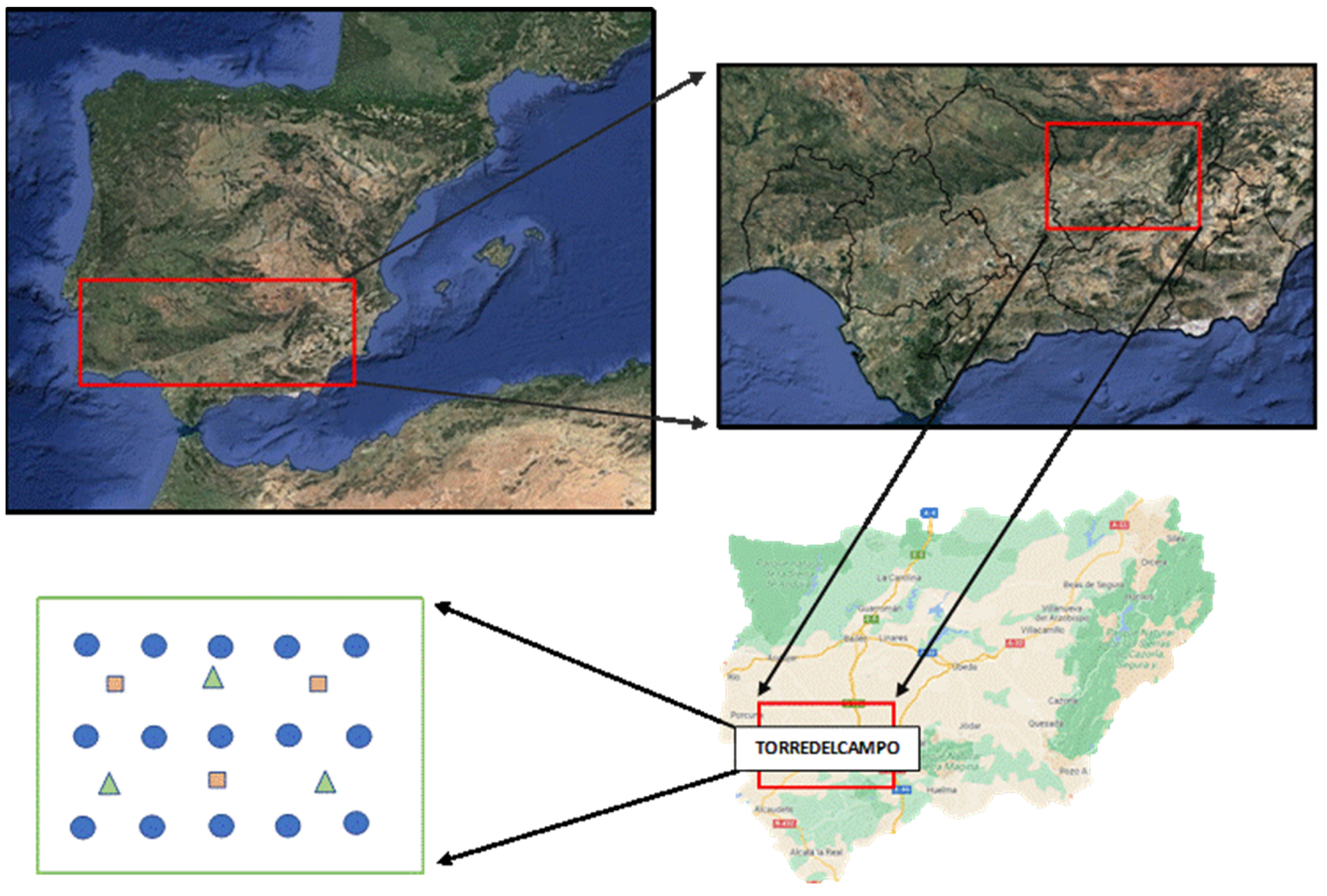
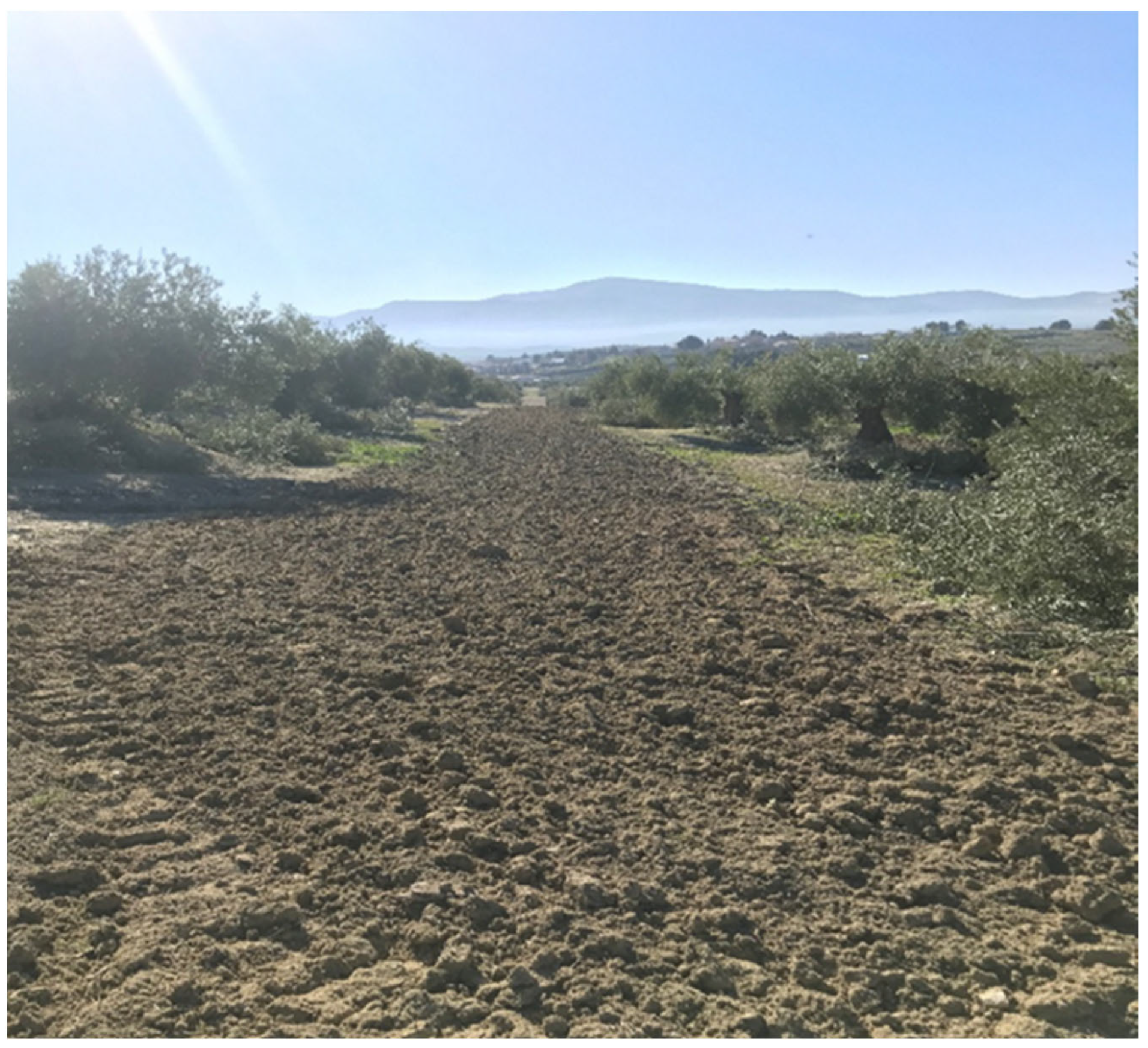
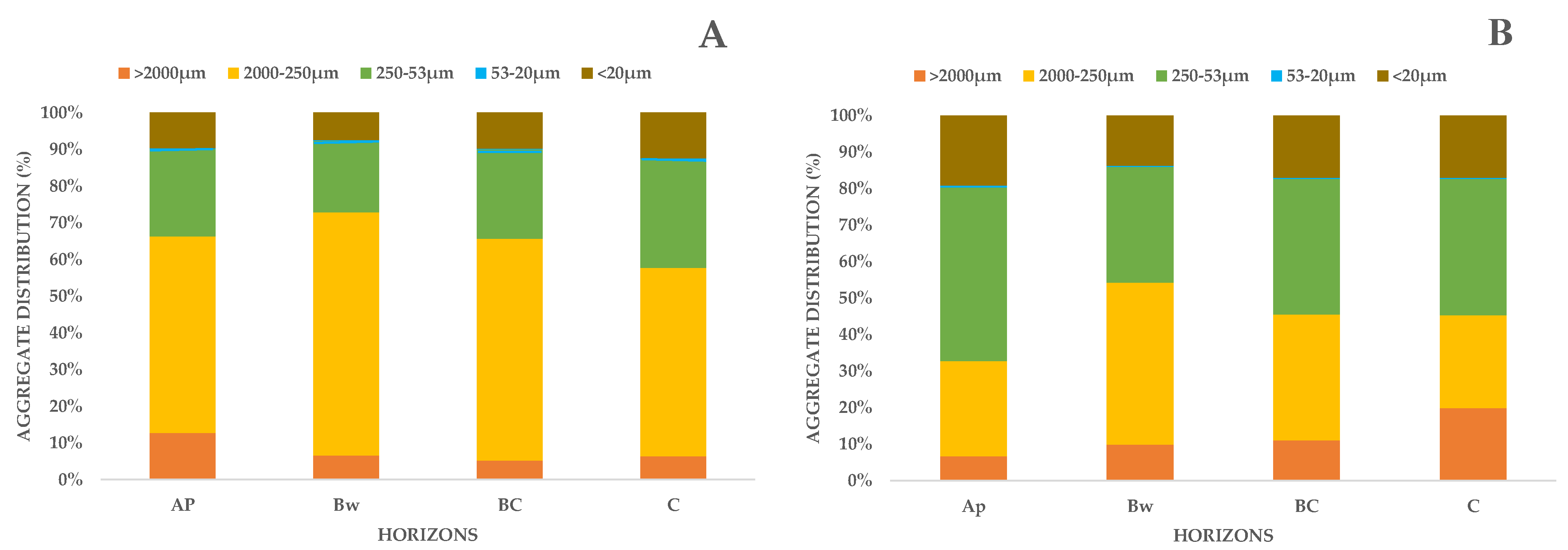
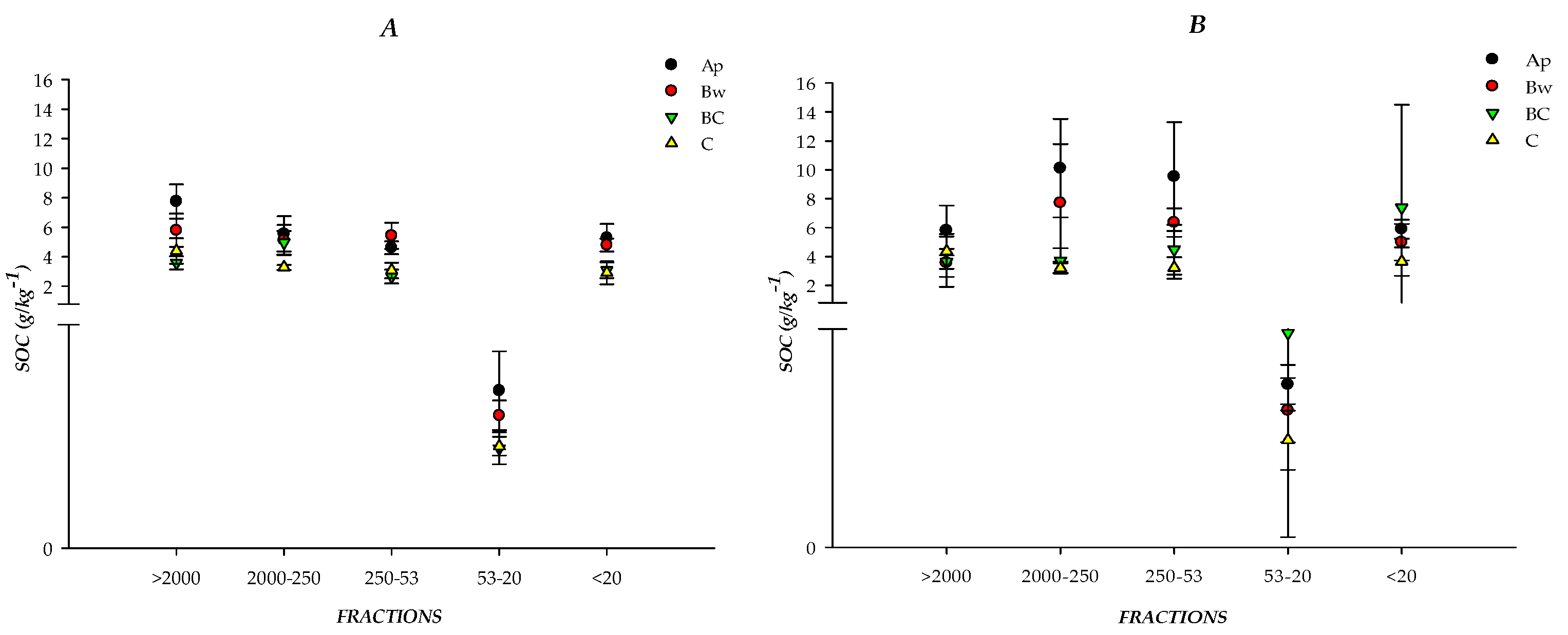
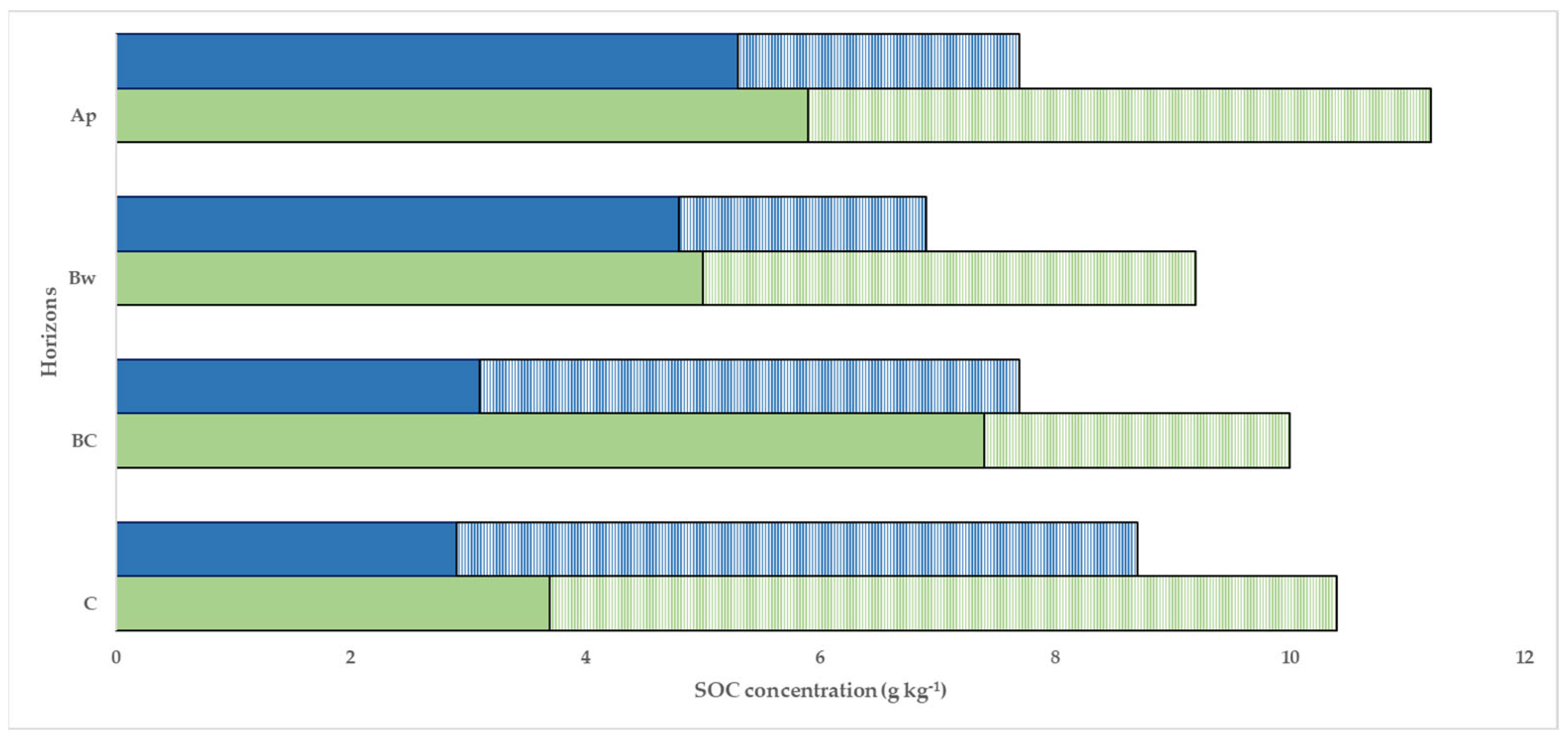
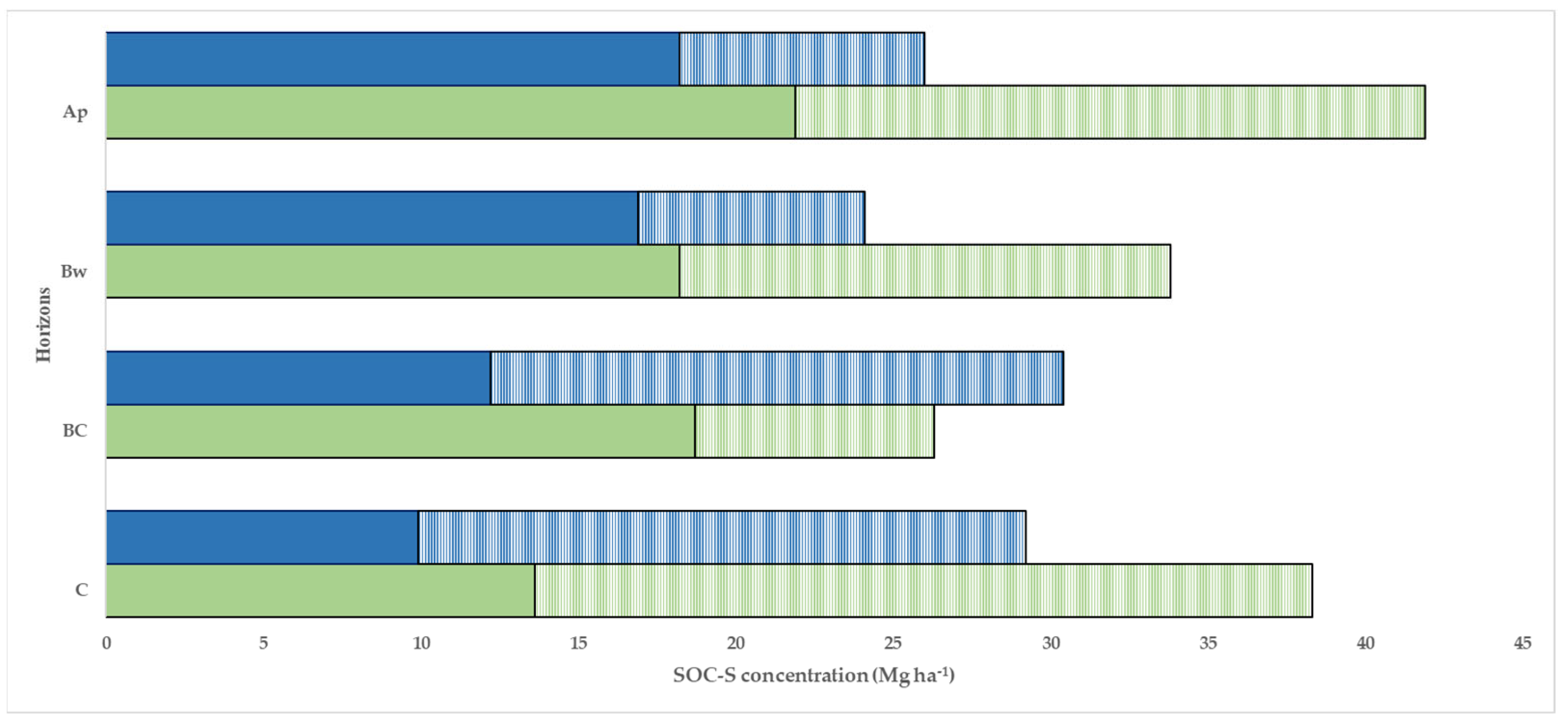
| Parameter | Description | References | |
|---|---|---|---|
| Climate | Mediterranean | [32] | |
| Climatic characteristics | Average annual rainfall | 485.92 mm | [33] |
| Average annual temperature | 16.7 °C | ||
| Maximum temperature of the period | 45.8 °C | ||
| Minimum temperature of the period | −9.6 °C | ||
| Relative humidity | 60.8% | ||
| Average annual reference evapotranspiration (ETo) | 1330.2 mm | ||
| Soil type | Calcaric Cambisols | [31] | |
| Soil properties | Clayey texture | Basic pH | [34] |
| Soil characteristics | Low fertility | Physical conditions not optimal | [27] |
| Land Management | Ch. | Hor. | Th (cm) | Depth (cm) | Gravel (%) | Sand (%) | Silt (%) | Clay (%) | BD (Mg m−3) |
|---|---|---|---|---|---|---|---|---|---|
| CT0 | CM-ca n = 9 2003 | Ap | 27.4 ± 1.1 | 0–27.3 | 12.6 ± 1.2 Aa | 8.6 ± 1.0 Aa | 19.5 ± 2.6 Aa | 71.9 ± 3.6 Aa | 1.42 ± 0.17 Aa |
| Bw | 28.3 ± 1.1 | 27.3–55.6 | 13.5 ± 1.3 Aa | 5.5 ± 1.3 Ba | 22.7 ± 3.1 Aa | 71.8 ± 4.4 Aa | 1.43 ± 0.09 Aa | ||
| BC | 33.2 ± 1.1 | 55.6–88.8 | 17.6 ± 1.4 Ba | 3.8 ± 0.7 Ca | 24.7 ± 3.2 Aa | 71.7 ± 3.9 Aa | 1.44 ± 0.05 Aa | ||
| C | 26.4 ± 1.0 | 88.8–115.2 | 12.6 ± 0.8 Aa | 4.5 ± 1.0 Ca | 21.8 ± 1.9 Aa | 73.7 ± 2.9 Aa | 1.44 ± 0.10 Aa | ||
| CT1 | CM-ca n = 9 2018 | Ap | 32.7 ± 1.2 | 0–32.7 | 15.6 ± 1.1 Aa | 9.0 ± 0.3 Aa | 19.3 ± 2.0 Aa | 71.7 ± 2.2 Aa | 1.35 ± 0.03 Aa |
| Bw | 32.4 ± 0.8 | 32.7–65.1 | 15.7 ± 1.3 Aa | 3.7 ± 0.2 Ba | 21.3 ± 2.1 Aa | 75.0 ± 2.3 Ba | 1.34 ± 0.04 Aa | ||
| BC | 24.6 ± 1.0 | 65.1–89.8 | 21.6 ± 2.1 Ba | 6.6 ± 0.9 Ba | 20.5 ± 1.2 Ab | 72.9 ± 2.1 Aa | 1.36 ± 0.06 Aa | ||
| C | 30.2 ± 0.9 | 89.8–120.0 | 12.4 ± 0.9 Aa | 9.5 ± 0.9 Ab | 21.5 ± 0.9 Aa | 69.0 ± 1.8 Ab | 1.39 ± 0.04 Ba |
| Land Management | Hor | pH (H2O) | OM (%) | SOC (g kg−1) | SOC-S (Mg ha−1) | T-SOC-S (Mg ha−1) |
|---|---|---|---|---|---|---|
| CT0 | Ap | 7.63 ± 0.26 Aa | 1.25 ± 0.06 Aa | 7.3 ± 0.38 Aa | 24.7 ± 2.5 Aa | 74.74 ± 1.5 |
| Bw | 8.08 ± 0.23 Aa | 1.01 ± 0.04 Aa | 5.8 ± 0.23 Aa | 20.2 ± 2.5 Aa | ||
| BC | 8.19 ± 0.16 Aa | 0.78 ± 0.05 Ba | 4.3 ± 0.26 Aa | 17.0 ± 0.5 Ba | ||
| C | 8.11 ± 0.19 Aa | 0.74 ± 0.06 Ba | 3.9 ± 0.29 Ba | 12.9 ± 0.4 Ba | ||
| CT1 | Ap | 7.83 ± 0.09 Aa | 0.88 ± 0.05 Ab | 5.2 ± 0.27 Aa | 19.1 ± 0.20 Aa | 43.12 ± 0.20 |
| Bw | 8.08 ± 0.16 Aa | 0.59 ± 0.03 Bb | 3.4 ± 0.17 Bb | 12.4 ± 0.16 Ba | ||
| BC | 8.15 ± 0.10 Aa | 0.40 ± 0.03 Cb | 2.2 ± 0.16 Ba | 5.8 ± 0.15 Cb | ||
| C | 8.14 ± 0.08 Aa | 0.30 ± 0.02 Cb | 1.6 ± 0.01 Ca | 5.9 ± 0.26 Cb |
| Land Use | Hor | Depth (cm) | SMF/SOC (g kg−1) | Δ (<20 μm) % |
|---|---|---|---|---|
| <20 μm | Top/Sub soil | |||
| CT0 | Ap | 0–27.3 | 18.1 ± 1.2 Aa | |
| Bw | 27.3–55.6 | 15.7 ± 2.3 Aa | −13.7% | |
| BC | 55.6–88.8 | 31.6 ± 2.1 Ba | +75.5% | |
| C | 88.8–115.2 | 42.9 ± 1.6 Ca | +136.4% | |
| CT1 | Ap | 0–32.7 | 32.7 ± 9.0 Ab | |
| Bw | 32.7–65.1 | 27.5 ± 3.4 Ab | −15.9% | |
| BC | 65.1–89.8 | 21.7 ± 1.9 Bb | −33.6% | |
| C | 89.8–120.0 | 46.7 ± 5.1 Ca | +43% |
Publisher’s Note: MDPI stays neutral with regard to jurisdictional claims in published maps and institutional affiliations. |
© 2022 by the authors. Licensee MDPI, Basel, Switzerland. This article is an open access article distributed under the terms and conditions of the Creative Commons Attribution (CC BY) license (https://creativecommons.org/licenses/by/4.0/).
Share and Cite
Aguilera-Huertas, J.; Parras-Alcántara, L.; González-Rosado, M.; Lozano-García, B. What Influence Does Conventional Tillage Have on the Ability of Soils to Sequester Carbon, Stabilise It and Become Saturated in the Medium Term? A Case Study in a Traditional Rainfed Olive Grove. Sustainability 2022, 14, 7097. https://doi.org/10.3390/su14127097
Aguilera-Huertas J, Parras-Alcántara L, González-Rosado M, Lozano-García B. What Influence Does Conventional Tillage Have on the Ability of Soils to Sequester Carbon, Stabilise It and Become Saturated in the Medium Term? A Case Study in a Traditional Rainfed Olive Grove. Sustainability. 2022; 14(12):7097. https://doi.org/10.3390/su14127097
Chicago/Turabian StyleAguilera-Huertas, Jesús, Luis Parras-Alcántara, Manuel González-Rosado, and Beatriz Lozano-García. 2022. "What Influence Does Conventional Tillage Have on the Ability of Soils to Sequester Carbon, Stabilise It and Become Saturated in the Medium Term? A Case Study in a Traditional Rainfed Olive Grove" Sustainability 14, no. 12: 7097. https://doi.org/10.3390/su14127097
APA StyleAguilera-Huertas, J., Parras-Alcántara, L., González-Rosado, M., & Lozano-García, B. (2022). What Influence Does Conventional Tillage Have on the Ability of Soils to Sequester Carbon, Stabilise It and Become Saturated in the Medium Term? A Case Study in a Traditional Rainfed Olive Grove. Sustainability, 14(12), 7097. https://doi.org/10.3390/su14127097







